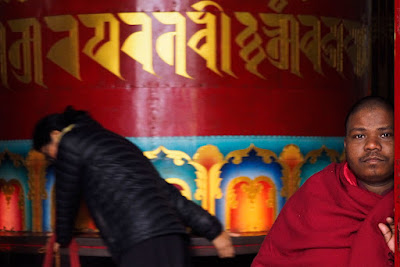Del libro “La senda de las nubes blancas” de Lama Anagarika Govinda. Su nombre de nacimiento es, Ernst Lothar Hoffmann (Waldheim, Sajonia, 1898-Mill Valley, California, 1985).
Darshan: El encuentro y la contemplación mutua con una persona en silencio, sin necesidad de conversar.
De Wikipedia, La Enciclopedia Libre.
Darshan como veneración. El término Darśana significa visión y, a veces, aparición (el acto de mostrarse). Proviene de la raíz sánscrita dṛiś: ver, y se utiliza principalmente como visión de lo divino.
En la veneración hinduista, el Darshan es la contemplación de una deidad o de una persona santa: También la experiencia contemplativa de un lugar de especial belleza o circunstancia atemporal. La experiencia es, por lo general, concebida para ser recíproca y resulta una bendición para el observador.
Bodhgaya es el lugar, según la tradición budista, en el que el príncipe Siddhartha alcanzó la iluminación o nirvana. Actualmente es uno de los lugares de peregrinación más importante en India. El árbol Bodhi (Ficus Religiosa), bajo el cual meditó el Budha, mantiene, dos mil quinientos años después, un follaje de extremada belleza y grandiosidad.
Para los peregrinos volver a sus hogares con una de las hojas desprendidas del árbol de forma natural se convierte en una auténtica bendición, en un bien precioso.
De Lama Anagarika Govinda:
“Así, al contrario que la contemplación de un pasado que no podemos cambiar, sobre el cual no tenemos la menor influencia, la meditación sirve para sembrar las semillas de la liberación final y a construir ahora mismo los cuerpos de la perfección futura a imagen de nuestros más altos ideales”
Del libro Jule Ladakh:
“La meditación crea un Universo de Sabiduría. La Luz que esto provoca ilumina todas las acciones de nuestra vida cotidiana”
----------------------------------------------------------
From the book "The Path of the White Clouds" by Lama Anagarika Govinda. His birth name is Ernst Lothar Hoffmann (Waldheim, Saxony, 1898-Mill Valley, California, 1985).
Darshan: The encounter and mutual contemplation with a person in silence, without the need for conversation.
From Wikipedia, The Free Encyclopedia.
Darshan as worship. The term Darśana means vision and sometimes appearance (the act of showing oneself). It comes from the sanskrit root dṛiś: see, and is used primarily as a vision of the divine.
In hindu worship, Darshan is the contemplation of a deity or a holy person: It is also the contemplative experience of a place of special beauty or timeless circumstance. The experience is usually designed to be reciprocal and is a blessing for the observer.
Bodhgaya is the place, according to buddhist tradition, where prince Siddhartha attained enlightenment or nirvana. Today it is one of the most important places of pilgrimage in India. The Bodhi tree (Ficus Religiosa), under which the Buddha meditated, maintains, two thousand five hundred years later, a foliage of extreme beauty and grandeur.
For the pilgrims to return home with one of the leaves naturally detached from the tree becomes a real blessing, a precious good.
From Lama Anagarika Govinda:
"Thus, unlike the contemplation of a past we cannot change, over which we have no influence, meditation serves to sow the seeds of final liberation and to build right now the bodies of future perfection in the image of our highest ideals.
From the book Jule Ladakh:
"Meditation creates a Universe of Wisdom. The Light that this provokes illuminates all the actions of our daily life"






















Precioso reportaje.
ResponderEliminar